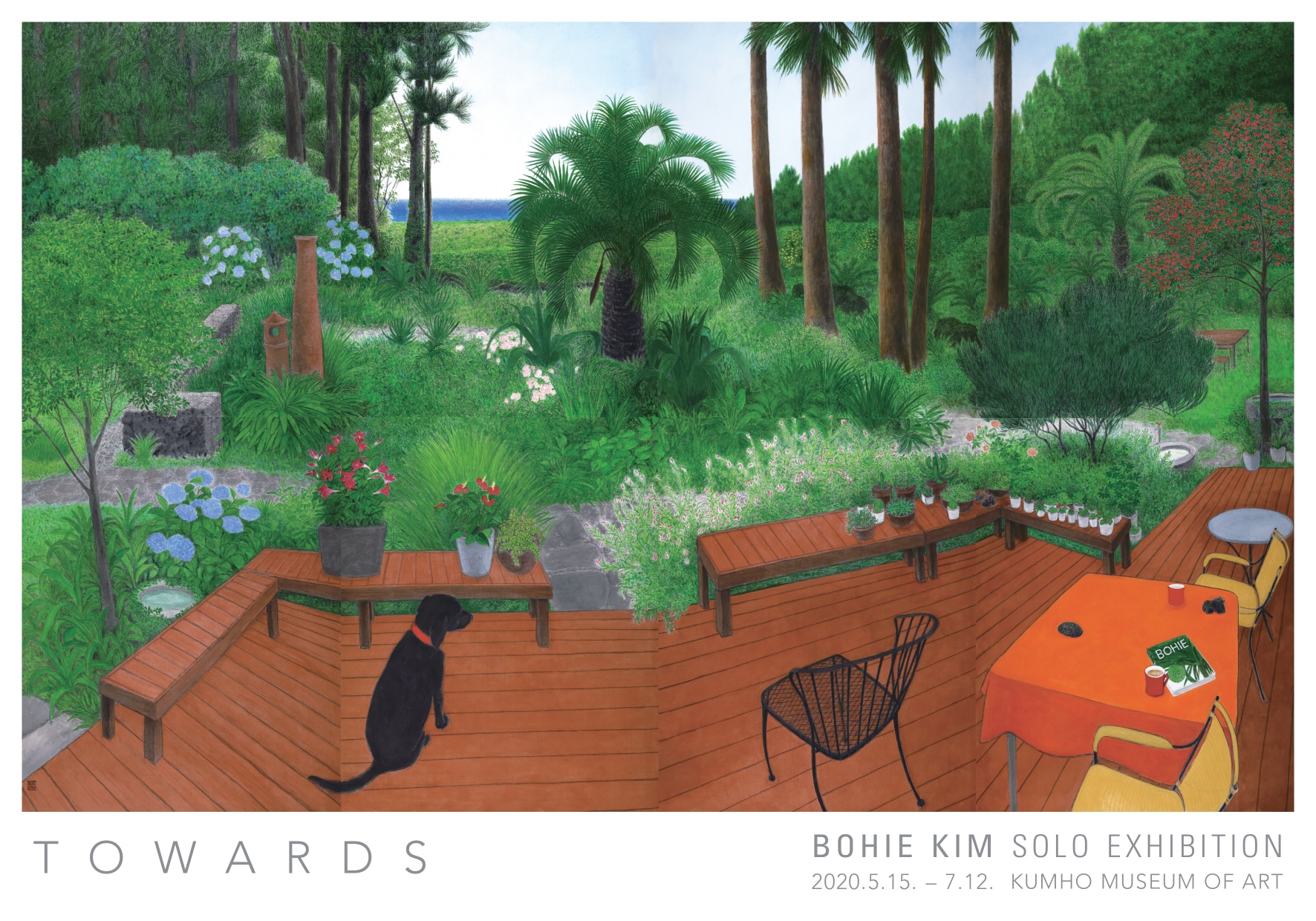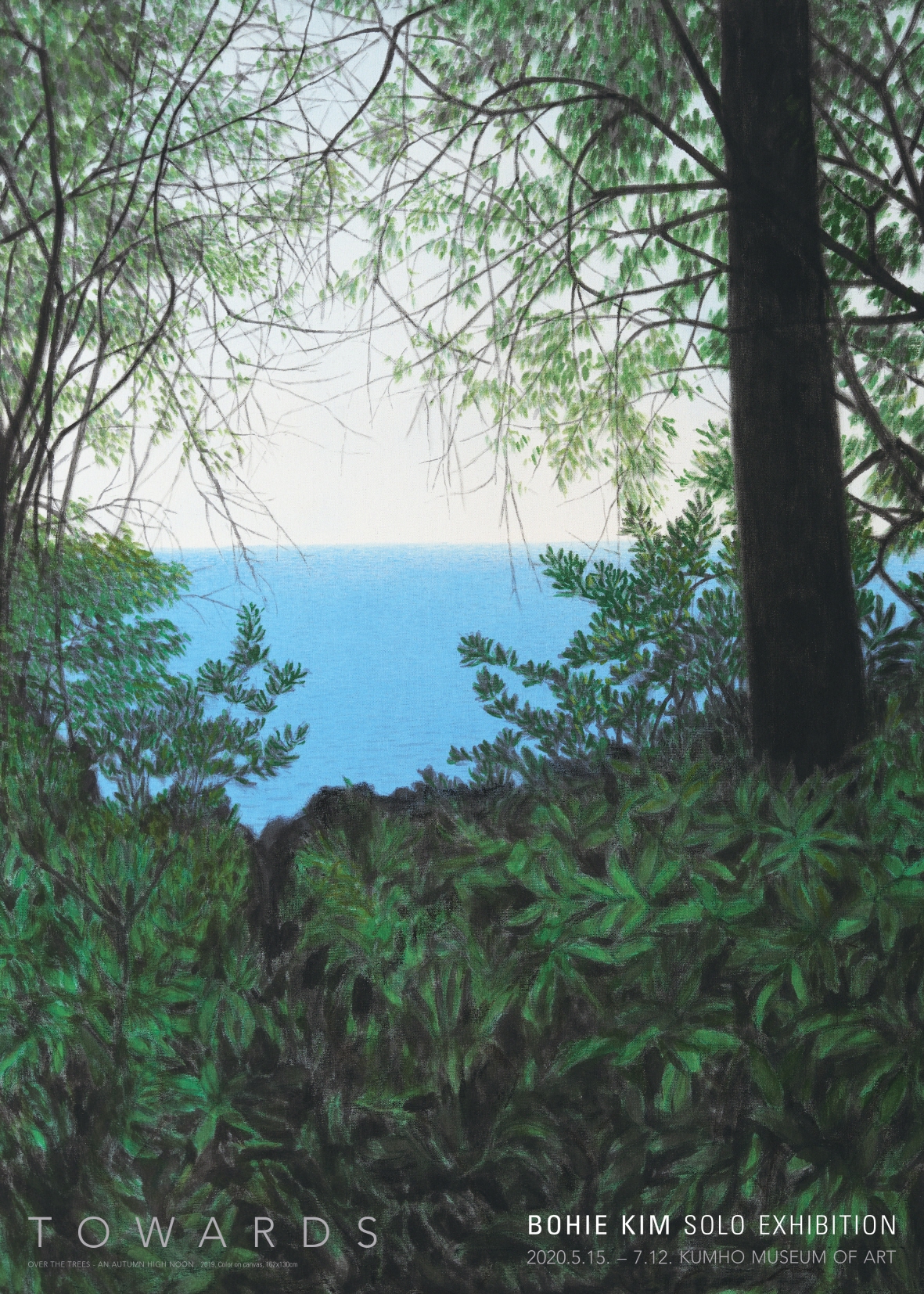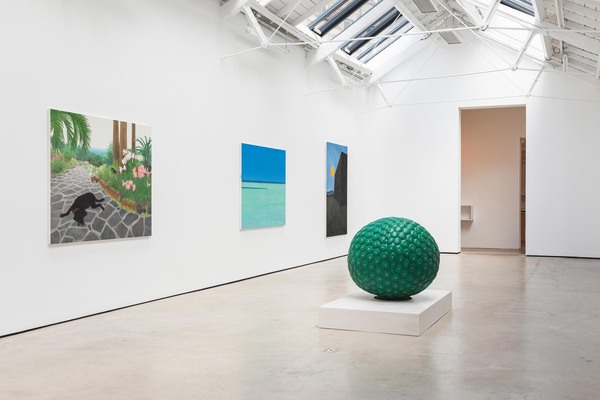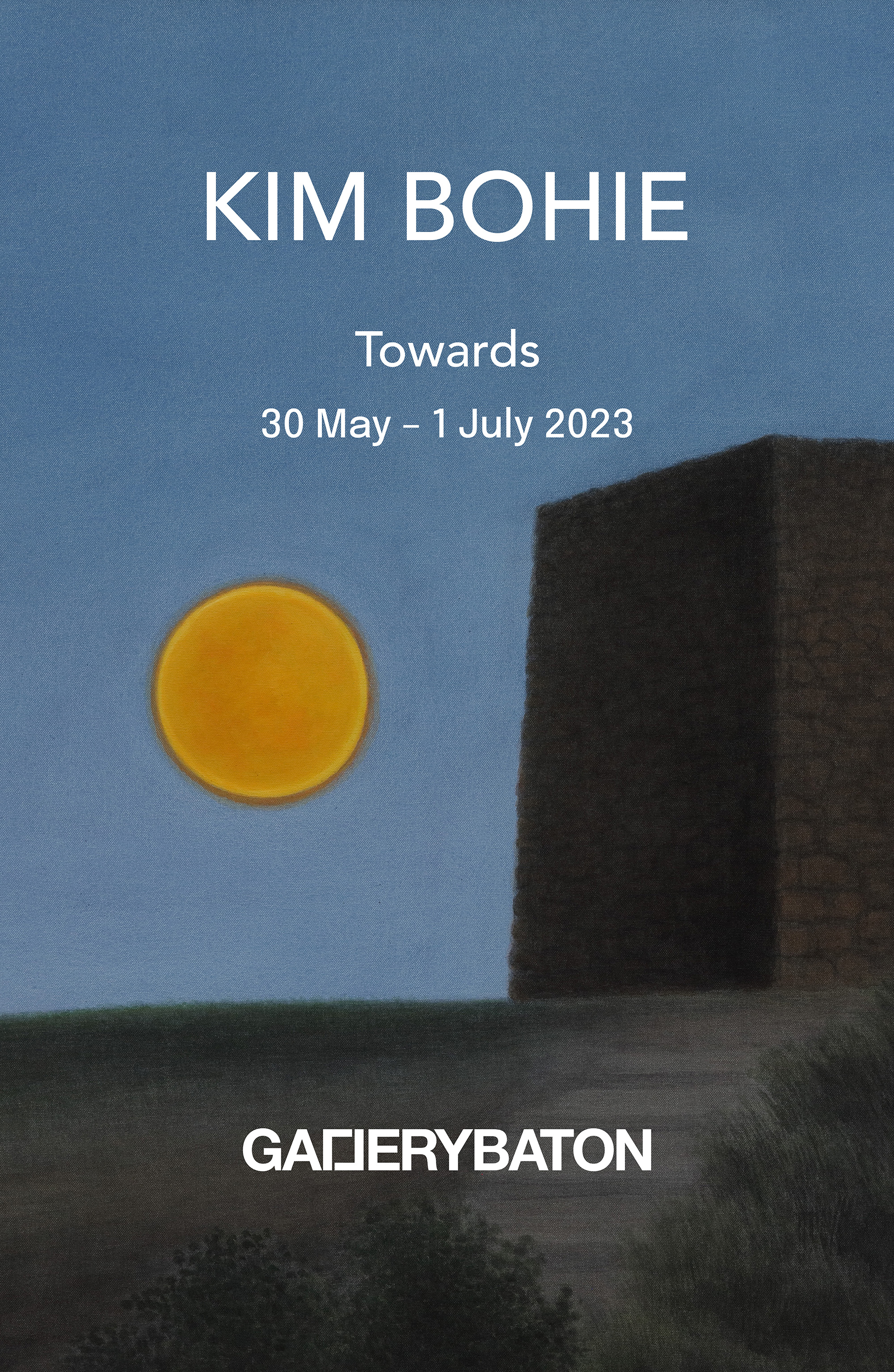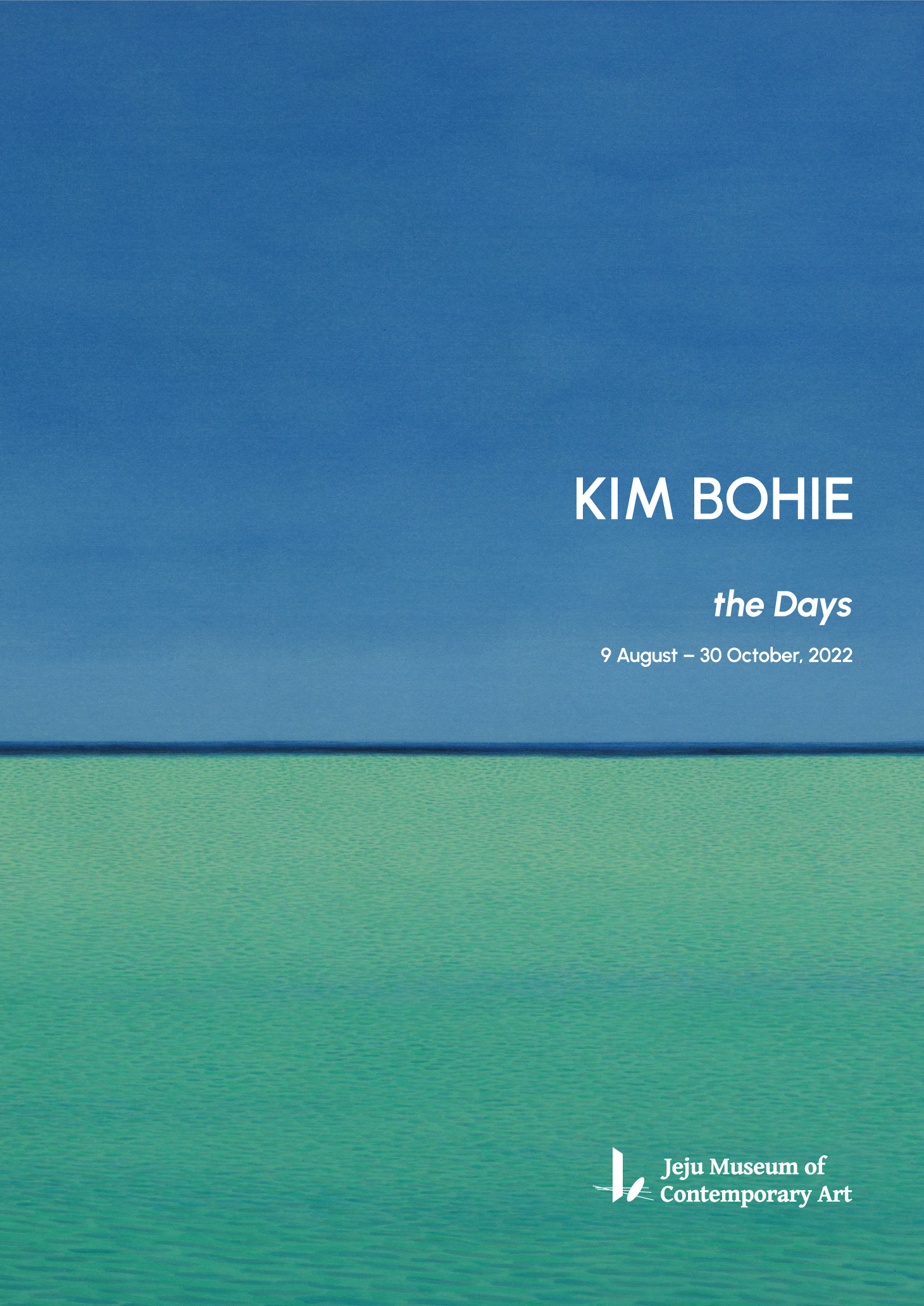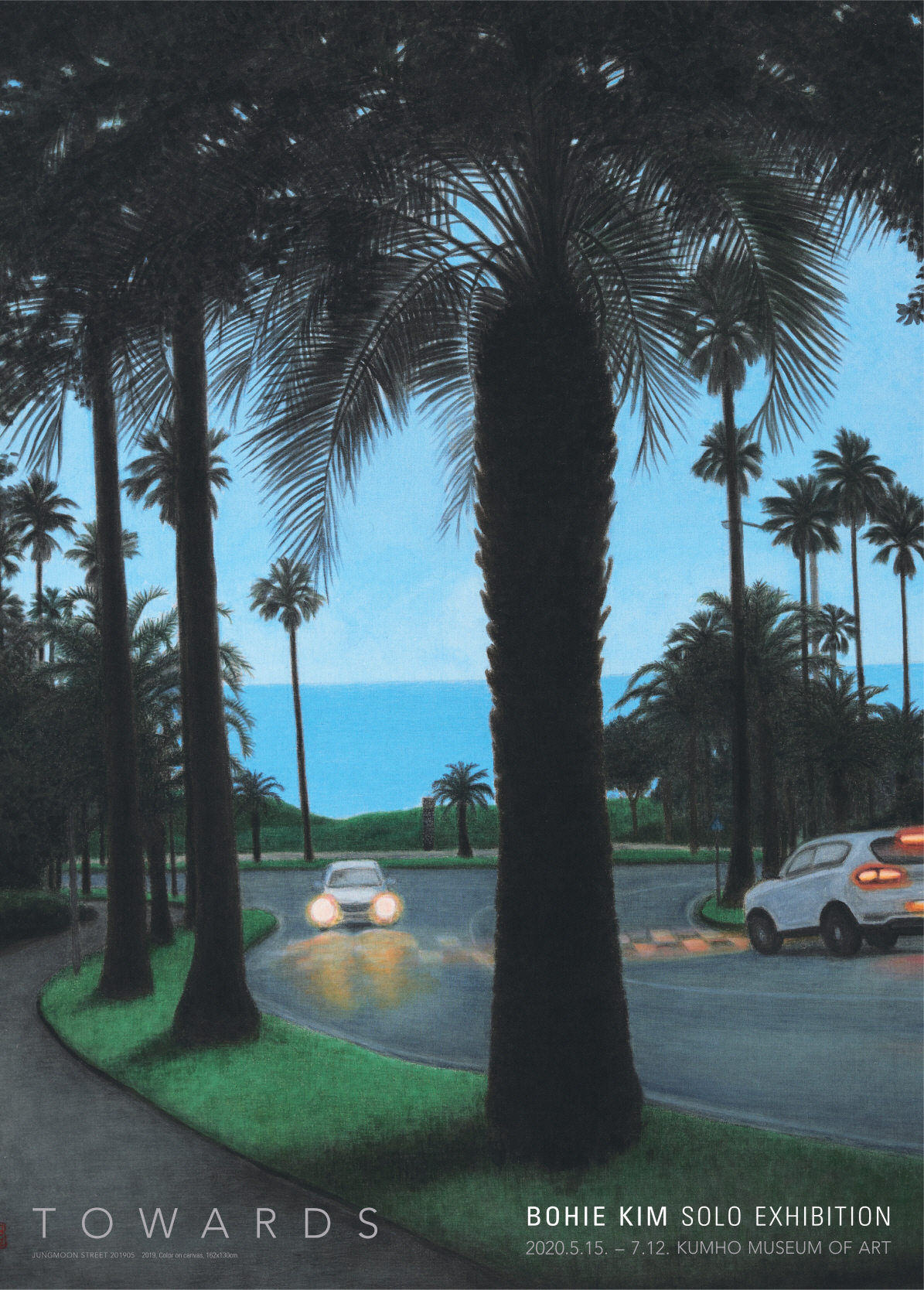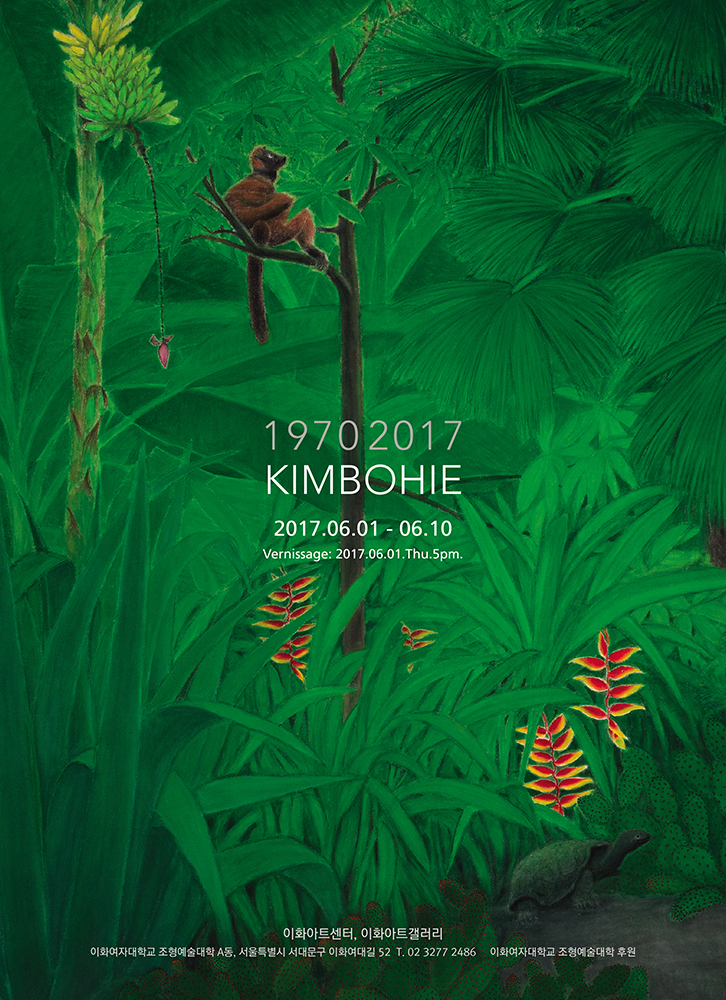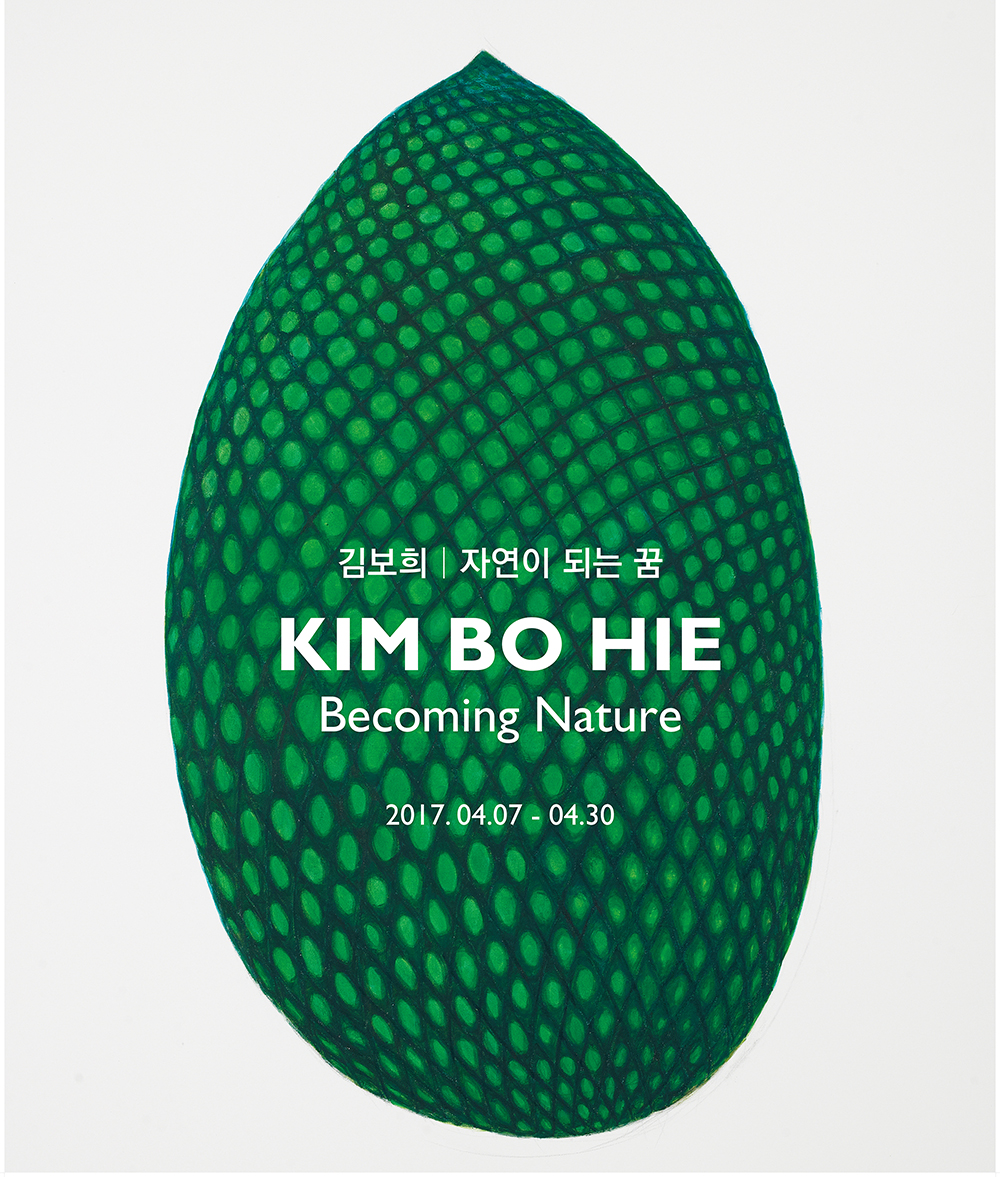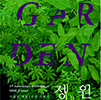순수의 전조:
한 송이 꽃에서 발견한 우주
기혜경 (부산시립미술관장)
작가 김보희는 제주의 풍광을 그린다. 작가가 제주를 왕래하기 시작한 것은 무척이나 오랜 일이지만 제주를 제2의 터전으로 삼기 시작한 것은 2000년대 초반을 넘어서이다. 제주 정착 이후 작가는 화제를 찾아 따로 시간을 내어 길을 나서기보다는 제주의 일상에서 만나는 것에 눈 돌린다. 자신의 일상 속에 개입해 들어온 주변의 것들을 화면 속에 재배치한다. 매일 마주하는 집 앞 정원과 그곳에서 만난 풀잎, 꽃송이, 나무와 새, 산책길에서 만나는 바다와 제주의 풍광, 그 속에 담긴 변화들이 그의 작업을 구성한다. 이미 삶 속 깊숙이 들어와 있는 익숙한 대상에서 출발하여 그들이 드러내는 사소한 변화에 주목하고 그것을 화면에 옮기는 것이다. 매일 자고 일어나면 보는 것들이지만 어제 봉우리를 맺었던 꽃대에 오늘은 꽃이 피고, 내일은 열매가 맺힌다.
이번 전시의 제목인 ‘Towards’는 그러한 변화를 함의한다. 영어의 전치사인 ‘towards’는 ‘무엇인가로 향하는, 혹은 어떠한 방향성을 지시하며 “~로”’ 정도의 뜻을 갖는 단어이다. 하지만, 이 단어는 그것 자체로 정확한 목적지를 드러내지 못하고 함께 연동되는 단어들에 의해 지향점을 드러낸다. ‘Towards’를 제목으로 선택한 이번 전시에서 작가는 그 연동되는 단어의 역할을 자신이 제주에서 만난 다양한 풍경과 식물들에게 맡긴다.
제주의 일상에서 만난 풍경과 식물들은 김보희의 작업에 시간과 그에 따른 변화가 본격적으로 개입하게 한다. 화면 속에 시간의 변화와 날씨 및 자연의 변화가 세세하게 드러나는 계기를 제공한다. 물론 이전 시기 제작한 산수 작업에서도 물안개 피어오르는 새벽녘이나 붉은 노을이 깃든 해질녘의 산야를 통해 시간성을 어느 정도 드러내긴 하였다. 하지만 제주 생활 이후 전격적으로 화면의 전경으로 끌어당겨 배치된 대상과 그것들이 드러내는 변화, 그 속에 함축한 시간은 김보희 작업의 특성으로 자리 잡는다.
<Over the Trees – A Summer High Noon>과 <Over the Trees – An Autumn High Noon> 같은 작업들, <Jungmoon Street 201904>처럼 제주 중문의 봄을 그린 작업, 혹은 중문의 여름과 가을을 담은 작업들은 인상주의 작가들의 그것처럼 대기 중 수분의 농도와 빛의 강도, 그리고 그러한 차이로 인해 드러나는 대상의 변화를 살필 수 있게 한다. 이들 작품에서 작가는 한순간 눈이 인식한 빛의 차이와 그를 통한 시간성을 화면 위에 구축한다. 하지만, 정작 시간과 관련한 작가만의 독자적인 방식은 시간의 흐름과 그것이 초래한 변화에 초점을 맞춘 작업들에서 좀 더 선명하게 드러난다.
27개의 캔버스를 이어 붙여 제작한 <The Days>는 작가 특유의 시간 개념과 그것이 초래한 변화를 살필 수 있는 작업이다. 이 작품은 화면 왼쪽에 새벽 바다를, 오른쪽 상단에 밤하늘을 배치하고 있다. 또한, 화면 속에 피어있는 꽃과 열매는 현실 세계에서는 하나의 계절에 함께 피어나지 못하는 것들이다. 이것은 이 작품이 하루라는 시간, 더 나아가 식물의 순환 주기를 함축하여 포괄하고 있음을 의미한다. 현실의 자연을 대상으로 하였지만, 2년에 걸쳐 작업한 이 작품 속 세상은 있는 그대로의 자연이라기보다는 작가가 만든 세계이자 심상의 풍경이다. 현실에서 발견한 대상에서 출발하였지만 현실에서는 만날 수 없는 풍광으로 태어난 것이다.
시간과 자연의 순환 주기를 함축한 <The Days>에서 보여준 자연에 대한 묘사 방식은 작가가 이전 시기 산수를 구성하던 방식과는 확연한 차이를 드러낸다. 2000년을 전후하여 완성한 김보희식 산수는 전통 동양화의 시각 방식에 근거하여 바라다보는 대상으로서의 산수였다. 관람자가 산수를 즐길 수 있도록 고안된 동양화의 시각 방식은 사람들이 산을 마주할 때 흔히 취하는 올려다보기, 비스듬히 내려다보기, 멀리 바라다보기 방식을 구사한다. 서양 미술이 르네상스 이래 추구해왔던 한 시점에서 대상을 보는 일점 투시법과는 달리 동양화의 시각 방식은 관람자로 하여금 산수 속을 실제 시각적으로 돌아다닐 수 있게 한다. 동양화를 전공한 작가는 이중 멀리 바라다보기 방식을 적극 활용하여 김보희식 산수의 전형을 마련한다. 조금 높은 곳에서 혹은 좀 멀리 떨어진 곳에서 바라다보고 건너다본 산수를 중경과 원경에 배치함으로써 화면은 차분히 가라앉은 산자락과 잔잔한 물의 흐름이 있는 서정적인 분위기를 드러낸다. 산을 돌아 흐르는 강의 유선적 흐름은 여러 개의 이어진 화면을 통해 파노라마적 경관을 구성하며 돌아가야 할 포근한 회귀처로서의 자연을 일깨운다.
<The Days>는 이전 시기의 산수에서 보여주었던 위와 같은 멀리 바라다보기 방식에서 벗어나 주변의 가까운 것으로 작가의 시선이 옮겨온 작업이다. 이전 작업이 바라다보며 관망한 산수를 화면에 담기 위해 중경과 원경을 활용하였다면, 이제 작가는 제주의 삶 속에서 만나는 식물들을 화면에 담기 위해 화면 근경으로 대상을 바짝 당겨 배치한다. 이로 인해 대상은 가까이에서 자세히 관찰해야 하는 것으로 변화하며, 작가는 시간을 들여 이들을 관찰한다. 그 결과, 산수 작업이 먹의 농담과 명암으로 산과 숲의 존재를 암시하는 방식이었다면, 시간을 들여 관찰하고 살핌으로써 <The Days> 속 풀과 나무, 식물들은 구체적인 부피와 무게, 음영을 가진 생명 있는 존재로 드러난다. 싱싱하게 물이 오른 초록의 줄기와 잎, 꽃을 품은 꽃대, 열매를 맺은 나무들은 녹색의 변주를 통해 그것 자체로 태초의 생명력을 드러낸다. 정확한 관찰과 세밀한 묘사를 통해 작가가 화면에 심어 놓은 식물들은 찬란한 생명력을 부여받고 있다. 나무와 풀과 꽃들이 뿜어내는 푸르름은 있는 그대로의 살아있음과 생명 있는 것들의 표식이다.
눈부시게 빛나며 생명력을 뽐내는 식물들이 어우러져 만들어 낸 풍광은 하지만 현실의 그것은 아니다. 그곳에는 새벽부터 밤까지의 시간과 하나의 씨앗에서 꽃이 피고 열매를 맺는 자연의 순환 주기가 스며들어 있다. 한순간을 선택한 것이라기보다는 시간의 흐름과 그에 따른 자연의 변화를 함축하고 있다. 이를 위해 작가는 전통적인 동양화의 오른쪽부터 시작하여 왼쪽으로 이어지는 화면 구성법 대신 왼쪽에 새벽을 오른쪽에 밤을 포치하고 있다. 이는 전통 동양화의 어법을 고려하지 않은 때문이라기보다는 오히려 이 화면 속 시간이 돌고 도는 것임을 드러내기 위한 것이라 할 수 있다. 폴 고갱(1848~1903)이 말년작 <우리는 어디에서 왔고, 우리는 무엇이며, 어디로 가는가?>에 자신의 근원에 대한 질문을 담았던 것처럼, 김보희는 <The Days>에 새벽에서 밤으로 그리고 밤에서 다시 새벽으로 향하는 시간과 그 시간의 변화 속에서 이루어지는 싹이 나고 꽃이 피고 열매를 맺는 자연의 순환을 담고 있다. 자연의 모습과 그 이면의 변화에 주목하고, 풍경 너머의 것을 이야기하는 작가는 생명이 갖는 힘을 화면 위에 영속시킨다. 그것은 인간이 관여하기 이전의 자연 자체의 생명력이자 작가가 꿈꾸는 이상향이며, 이런 의미에서 <The Days>는 제주의 풍광을 주제로 작가가 써 내려간 한 편의 대서사라 할 수 있다.
매일 만나는 일상적인 풍경을 통해 자연의 이치와 생명의 순환을 드러내는 김보희의 작품 속에는 관객의 눈앞으로 바짝 다가서며 푸르름을 뽐내는 식물들이 등장한다. 파노라마 형식의 거대한 화면 위에 등장하는 이들은 중심과 주변의 차이를 무화시킬 정도로 모두가 강렬한 생명의 힘을 발산한다. 이런 효과는 하나의 시점에서 대상을 살핀 것이 아니라 각 대상들을 가장 잘 관찰할 수 있는 시점에서 살핀 후 그것을 하나의 화면 안에 재구성함으로써 도달한 것이다. 이러한 보기 방식은 이전 시기 산수를 제작하며 활용하였던 전통적인 평원법을 좀 더 적극적으로 활용한 것이며, 이를 좀 더 극적으로 밀고 나가 화면 전면으로 끌어올린 작업이 <The Terrace>이다. <The Terrace>는 여러 개의 캔버스를 연결하여 하나의 풍경으로 완성한 작품이다. 작가의 거실에서 뜰로 향하는 길목에서 만나는 테라스를 대상화한 이 작업에서 각 캔버스는 서로 다른 시점에서 바라본 테라스와 뜰을 화면 위에 안착시킨다. 마치 각각이 다른 위치에서 대상을 촬영하여 그것을 이어 붙인 후, 어긋난 시점의 차이를 보정하지 않은 채 그대로 제시한 듯 보인다. 그로 인해 발코니의 난간과 바닥면은 서로 이어지지 못하는 선들로 화면 위에 드러난다. 이러한 화면 구성은 데이비드 호크니(1937~)의 화면 구성법을 연상시키지만, 호크니가 인간의 눈과 시각이 작동하는 방식과 맞지 않게 확립된 서양의 원근법이나 카메라의 시점에 대항하여 자신만의 해법을 동양 산수화와 폴 세잔(1839~1906)의 다시점에서 찾았다는 점을 감안한다며, 작가가 기존의 평원적 산수와 식물 풍경을 제작할 때 활용하였던 전통적인 보기 방식을 이 작품에서는 보정 없이 제시한 것임을 알 수 있게 한다.
한편, <The Terrace>를 구성하는 각 캔버스는 동일한 시간의 테라스와 정원의 풍경이 아니다. 하나의 작품 속에 개입해 들어간 서로 다른 시간대는 제주 정착 이후 작가의 중요한 화두를 형성한다. 특히, 2017년을 전후하여 제작한 <Towards>로 이름 붙여진 작품들은 상당히 이례적인 방식으로 다가온다. 차창을 통해 내다보이는 풍경과 차 유리창에 반사된 이미지를 하나의 화면에 담은 이들 작업은 화면에 다층 구조를 형성한다. 화면에는 구체적인 숫자와 문자의 나열로 이루어진 벽체와 거기에 개입하여 들어가듯 차 유리창 위를 스치고 지나가는 풍광들이 오버랩 된다. 황혼녘의 붉은빛을 머금은 화면은 빠르게 스쳐 지나가는 차창 밖 풍광처럼 흐르는 시간을 상징하는 숫자들의 연속으로 이어진다. 유리면에 반사된 무감각한 숫자들과 서로 다른 층위를 이루며 드러나는 이미지는 황혼녘의 시간과 어우러지며 현재의 시간이 단순히 현재만의 것이 아닌 과거와 미래가 중첩되고 교차된 것임을 알려준다. 꼬리를 물고 이어지는 숫자와 그것을 파열하는 글자, 중첩된 이미지들을 통해 여러 층을 형성한 화면은 다양한 내러티브를 잉태한다. 하지만, 관람자의 시선은 화면 속으로 이행되어 들어가지 못하고 평면화된 벽체로 인해 스쳐 지나가는 풍광처럼 화면 위를 미끄러진다. 이 시리즈의 작업들은 화면의 근경을 빽빽하게 메웠던 제주의 식물을 다룬 작업들보다 더 강렬하게 관람자의 시선을 되받아친다. 한국화를 전공하고 여전히 분채를 사용하며, 자신의 몸에 배어 있는 동양화의 전통적 시각 방식을 이용하여 화면을 구성하지만, 이제 화면은 관람자가 작품 속을 소요할 수 있는 공간이기보다는 지속적으로 미끄러지며 시선을 되받아쳐내는 납작한 공간으로 드러난다. 이는 작가가 전통을 고착화하기보다는 오늘을 사는 우리들의 상황을 드러내며 소통하는 방식을 고안하기 위해 그것을 지속적으로 동시대화시키고 있음을 의미한다.
이상에서 살펴보았듯이 시간의 흐름과 그로 인한 변화를 작업의 중요한 소재로 다루는 김보희는 작품을 통해 흐르는 시간 속에서 살아가는 존재들이 드러내는 생명의 힘과 그 힘의 순환구조를 엿볼 수 있게 한다. 이는 작가가 생명 있는 것들을 소중히 여기며 오래 보살피고 관찰하며 터득한 것이자, 인간 본위의 태도에서 벗어나 함께 어우러져 살아가는 동행자로 주변의 것들을 받아들임으로써 가능해진 것이다. 일상에서 만나는 생명 있는 것들에 대한 존중과 사랑은 그들이 관람자에게 단순히 보여지는 대상이 아닌 서로 마주하며 서로의 존재를 인정하게 한다.
김보희의 식물들이 드러내는 당당함과 생명력은 이번 전시에 출품된 거대한 꽃이나 씨앗으로 이어진다. 커다란 캔버스에 배경 없이 등장하는 꽃과 씨앗들은 그 자체로 화면 위에 당당하게 존재감을 과시한다. 이들 작업은 작은 씨앗이나 꽃 속에 깃든 생명의 힘을 극대화하여 드러내고 있다. 하지만 화면 위에 드러난 씨앗은 정작 자연에서 채취한 모습 그대로는 아니다. 작가는 이들을 확대하는 과정에서 다양한 변형을 가한다. 이 과정을 통해 씨앗들은 그 자체로 또 다른 변화의 가능성을 잉태한 변형태가 되며, 그 변화의 가능성은 순환 과정을 살필 수 있는 기재로 작동한다. 돌고 도는 순환의 원리를 씨앗 속에 담고 있는 것이다. 이는 마치 작은 망울에서 화려한 꽃을 피우고 그것이 시들어 다시 열매를 맺는 과정에 자신의 삶을 비유한 <Self Portrait>처럼 하나의 씨앗 속에 자연의 순환 원리를 집약한 것이라 할 수 있다. 이런 의미에서 ‘Towards’라 이름 붙여진 이번 전시는 윌리엄 블레이크(1757~1827)가 「순수의 전조」(1863)에서 읊었던 ‘한 알의 모래 속에서 우주를 보고 한 송이 들꽃에서 천국을 보는 것’과 같이 일상에서 만난 생명 있는 것들에서 찾아낸 그것 너머의 이야기임을 알 수 있게 한다.
Auguries of Innocence:
The Universe Found in a Flower
Hey-Kyung Ki (Director, Busan Museum of Art)
Bohie Kim portrays Jeju landscapes. It has been a long time since she started to travel to and from Jeju, but it was after the early 2000s that she took Jeju as her second home. Since settling down there, she began turning her eyes to the things that she comes across in her everyday life rather than making time to explore new subject matter. She rearranges things that she finds in her daily life on the canvas. Her paintings consist of the garden that she sees every day, the leaves, flowers, trees, and birds that she encounters there, the sea, Jeju landscapes that she views on the walkway, and the changes that contained in them. Involved in familiar objects which have already penetrated her life, she pays attention to the minor changes they reveal, and puts them on the canvas. They are things she sees every morning, but a flower blooms today from a bud put forth yesterday and a fruit will be borne tomorrow.
The exhibit title Towards is suggestive of such change. The dictionary definition of the English preposition “towards” includes “in the direction of,” indicating an orientation. Even so, this word cannot express an exact destination when used alone as it discloses its direction with the help of other words that are used with it. In this exhibition that chose Towards as the title, Bohie Kim entrusts the role of the linked word to various landscapes and plants that she has come across in Jeju.
The landscapes and plants she has encountered in her everyday life in Jeju allow Kim’s works to describe time and changes over time. They serve as a momentum to unveil temporal, weather, and natural changes in detail. Of course, temporality in her previous landscapes was more or less disclosed by mountains and fields around dawn when mist rises, or at sunset when the world is blazing red. However since her life in Jeju, Kim’s works have been particularly marked by objects drawn to the foreground of her scene, the changes caused by them, and time condensed within them.
Similar to the Impressionist paintings, changes in subject matter stemming from the concentration of moisture in the air, light intensity, and their differences can be discovered in her works such as Over the Trees—A Summer High Noon, Over the Trees—An Autumn High Noon, Jungmoon Street 201904, and other pieces featuring spring, summer and fall in Jungmoon. These paintings showcase differences of light as perceived by her eyes at a certain moment and the temporality brought on by this. And yet, her distinctive painting method pertaining to time is more vividly revealed in her works that highlight the passage of time and the changes caused by it.
Created by putting 27 canvases together, The Days is a work that suggests her own unique concept of time, and the change provoked by it. The sea at dawn is placed on the left while a night sky is arranged in the upper right-hand corner of the canvas. Flowers and fruits depicted in this painting are those which cannot bloom in the same season in reality. This means that this work includes and implies time of one day, and furthermore, the cycle of a plant. Although it deals with the nature of reality, the world in this work that she executed over the course of two years, is a world created by the artist and an imaginary landscape rather than a natural being. This work began from an object found in reality but was reborn as scenery we cannot find in real life.
Her way of portraying nature in The Days is implicative of the cycles of nature and time and is apparently different from her previous way of forging landscapes. A Bohie Kim-style landscape she completed around 2000 featured an object as seen from the standpoint of Oriental painting. Viewpoints of Oriental painting that were conceived to enable viewers to enjoy landscapes give shape to the way of looking up, looking down obliquely, and looking afar that people often take when facing the mountain. Unlike the one-point perspective pursued by Western art since the Renaissance, the viewpoint of Oriental painting causes viewers to visually travel around a landscape. Having majored in Oriental painting, she has completed the paragon of Bohie Kim-style landscape painting by making full use of the perspective of looking afar. By placing the landscape that viewed from a higher place or a little farther in the middle distance and the distant view of the canvas, her painting arouses a lyrical atmosphere with the subdued mountain edge and the flow of tranquil water. The meandering stream of a river flowing around a mountain forms a panoramic view on many of the canvases that are connected together, allowing us to view nature as a haven to which we must return.
The Days is a work in which she shifts her gaze to things up close, departing from the way of looking afar that was demonstrated in her previous landscapes. If her previous works can be described as utilizing the middle distance and distant view in order to capture the landscapes she viewed and observed, her newer works can be described as drawing objects close to the foreground in order to feature the plants she sees every day in Jeju. With this, the objects transform into things that should be observed up close, and the artist spends her time observing them. As a result, if her previous works alludes to the existence of mountain and forest by controlling the density of ink, the plants and trees in The Days are portrayed as vital beings with specific volume, weight and shade. This is conducted through observing them over time. Green stems and leaves freshly holding water, flower stalks embracing flowers, and trees bearing flowers and fruit reveal their own primal life force through variations of green. Plants brought to her canvas through close observation and minute description are invested with splendid vitality. Greenness emitted by these trees, grass, and flowers is a sign of aliveness and animation.
Despite all of this, this scene created by plants that glow and flaunt vitality is not one that can be found in reality. It is permeated by a span of time from dawn to night and the cycle of nature in which a bud sprouts from a seed, a flower blooms, and fruit is borne. This is not a depiction of just one moment, but a connotation of time and following change in nature. For this, she places a scene of dawn on the left and a scene of night on the right instead of adopting the composition of a traditional Oriental painting that starts from the right and continues to the left. This composition was perhaps adopted to unmask the cycles of time, not because she did not take traditional Oriental painting’s idioms into consideration. Just as Paul Gauguin (1848-1903) posed a question concerning the origin of our lives in Where Do We Come From? What Are We? Where Are We Going (1897-1898), a work done in his later years, The Days features time flowing from dawn to night and then night to dawn as well as the cycle of nature generated in changes over time. Paying attention to aspects of nature and its hidden changes, laying out narratives on something beyond landscape, the artist perpetuates the power of life on the canvas. This could be either the life force of nature itself before humans became involved or a utopia the artist dreams of. In this sense, The Days can be thought of as a grand narrative she wrote on the theme of Jeju scenery.
Bohie Kim’s works depict plants that approach our eyes and boast their greenness, unmasking the logic of nature and the cycle of life through quotidian scenes that she experiences every day. These plants, which appear in a panoramic form on the canvas, radiate a powerful sense of vitality to the extent that it might eliminates the difference between the center and the periphery. This effect is achieved through the reconstruction of objects in one scene after seeing each object from the best way to observe them as opposed to just one point of view. This way of seeing is a more active use of the traditional level-distance technique (平遠法, the technique of portraying an object while seeing it from eye level) that she employed in her previous landscapes. The Terrace is a work which more actively gives prominence to this technique. It was completed as a single scene by attaching many canvases together. An objectification of the terrace she sees on her way from her living room to her garden, this work features the terrace and the garden as seen from different viewpoints. It seems to put objects shot from different optical angles together and present them without correcting the difference in viewpoints. As a result, the balcony railing and the floor appear as broken lines on the canvas. This composition reminds viewers of the work of David Hockney (1937-). Hockney tried to find his own solution in Oriental painting and the multiple viewpoints of Paul Cézanne (1839-1906) going against Western perspective that established incongruously to the way that human eyes of camera angles work. Considering this fact, we realize that Kim presented the traditional way of viewing, which was used to produce plain landscape and plant scenery, without correction in this work.
The scenes of the terrace and garden The Terrace describes in each canvas are not those of the same time. Such different time zones involving in one painting became one of the overarching subjects in her works since her settlement in Jeju. In particular, the paintings titled Towards produced around 2017 appear considerably unprecedented. These works create a multi-layered structure by combining a scene seen through the car window and an image reflected onto the car window. There is an overlap between wall structures made up of numeric characters and landscapes brushing past the car window. The scene tinged with red at dusk showcases a continuation of numerals symbolic of time that flash past like scenes from a car window. The images revealed are different from that of insensible figures reflected on the surface of glass. They are in harmony with time at sunset, signaling that the present time overlaps with the past or the future. The scene in several layers composed of a train of figures, characters that disconnect them, and overlapped images lays out a wide array of narratives. However, the viewer’s gaze cannot get into the scene and slides on the canvas due to the two-dimensional wall structure, like scenery slipping by in a car window. This series of paintings draws the viewer’s attention more potently than other works featuring Jeju’s plants. Even though she majored in Korean painting, still uses powdered pigments, and forges compositions by adopting the traditional perspective of Oriental painting, her scenes are not in a space in which viewers are able to stroll but have become a flat area in which the viewers glide continuously. This means that the artist unveils situations of our time and tries to devise a way for communication, rather than making tradition something permanent.
As reviewed above, Bohie Kim allows viewers to catch a glimpse of the power of life unmasked in time by living things and the iterative structure of this power through her paintings, tackling the passage of time and the alterations caused by it as her work’s seminal subject matter. This has been possible since she has treasured and taken care of animate beings for a long time and embraced the things around her as her companions, breaking away from any human-centered demeanor. Her respect and love for the living things she comes across in her daily routine enable viewers to face and admit their existence instead of accepting them merely as things to be looked at.
The grandeur and life force her plants evoke are also aroused by grand flowers and seeds on show at this exhibition. They emerge without background images and gallantly flaunt their own presence on the canvas. These works show a maximization of the life force dwelling within them. All the same, the seeds depicted in her scenes are different from how they are in nature since she modifies them in diverse ways in the process of enlarging them. They develop the possibility of changing again through this process, which serves as an impetus to search for a cyclic process. In other words, they are laden with the principle of cycles. This is an integration of the principles of natural cycles in a seed, as demonstrated in Self-Portrait which likens her own life to the process; a flamboyant flower blooms from a small bud, withers, and again bears fruit. In this sense, the exhibition, titled Towards, seems to lay out a narrative on something that can be found in the living things we encounter in our everyday life, like in the line “To see the world in a grain of sand and heaven in a wild flower” that William Blake (1757-1827) sang in Auguries of Innocence (1863).
루소의 정글에서 바슐라르의 대지(大地)로
심상용 (미술사학 박사 / 서울대학교 교수)
루소의 정글과 김보희의 숲
‘길들여지지 않는 자연’이라는 관용구에는 탈문명에 대한 두려움이 내재되어 있다. ‘원시의 생명력’에도 암암리에 경계심이 배어 있다. 과거뿐만이 아니다. ‘미지의 미래’에서 미지(未知)도 낙원보다는 실낙원의 연상에 먼저 다가선다. 낙원에 대한 기대감은 쇄도하는 파국적인 미래에 묻히고 만다. 상상에 의존하고 이미지의 힘을 빌어야 하는, 경험하지 않은 비현실의 시간과 공간은 이내 불안과 두려움으로 채색되곤 한다. 이는 서구 사상의 오랜 전통이 이미지와 상상력의 작동을 오류와 허위의 주범으로 간주해온 중요한 원인이기도 하다. (질베르 뒤랑) 참된 실재를 추구한다는 서구 철학의 전통에서 상상력은 고작 이미지-실재의 껍데기에 불과한-의 뒤나 졸졸 따라다니는 정신적인 일탈로 폄훼되어왔다. 적어도 데카르트 이후의 계몽된 서구에서, 그리고 상상과 이미지에 대한 가스통 바슐라르(1884~1962)의 코페르니쿠스적 대반전이 있기 전까지, 현대인의 삶은 과학적 가설과 건설기계와 진화론으로 채워지면서, 비타 콘템플라티바(vita contemplativa), 곧 사색적 삶을 배제하고 비타 악티바(vita activa. 활동적 삶)의 삶에 매몰되어 왔다.
20세기 초 프랑스의 세관원 출신 화가 앙리 루소(1844~1910)의 정글 회화는 큐비즘으로 기울어지던 역사에 균형추를 제공했다. 루소의 이국적인 울창한 숲은 전적으로 그의 상상력의 산물이었다. 그는 생전에 단 한 번도 프랑스 영토 밖으로 나가 본 적도 없었다. 그의 동물들이 아동용 동물도감을 참고하여 그려진 것들임에도, 파블로 피카소(1881~1973)는 한눈에 그의 재능의 중심에 자신에겐 주어지지 않았던 어떤 것, 가스통 바슐라르가 비현실의 기능(la fonction de l’irréel)으로 이름 붙였던 것, 곧 상상력이 있음을 알아차렸다. 루소의 <여인의 초상>(1895)에서 받았던 영감이 아니었다면, <아비뇽의 처녀들>(1907)조차 탄생하지 못했을지도 모른다.
예를 들어 <잠자는 집시 여인>(1897)에는 루소의 재능을 구성하는 원소가 무엇인가가 잘 드러나 있다. 창백한 달빛 아래 실루엣을 드러낸 사막, 만돌린을 옆에 두고 잠든 전라의 여인, 그리고 꼬리를 치켜든 채 그녀의 머리맡에까지 다가온 사자의 비현실적인 조합이 만들어내는 분위기는, 장 콕토(1889~1963)에 의하면 불가사의한 긴장감과 정적으로 위장한 위험이다. <뱀을 부리는 여자>(1907)에서 긴장감은 여전히 은밀하지만 한층 고조된다. 야심한 시각, 여인의 피리 소리에 맞추어 뱀들이 꿈틀거린다. 또 다른 그림의 평화로워 보이는 정글의 반쯤 가려진 곳에서는 호랑이가 물소를 급습한다. 루소의 상상과 어설픈 묘사 덕에 맹수의 사냥이 덜 사실적으로 보이긴 하지만, 그것으로 이 숲이 여전히 약육강식의 장소이자 죽음이 상비된 공간임을 다 감출 수는 없다. 불시에 먹잇감을 덮치는 호랑이는 <밀림의 폭풍>(1891)에서도 등장한다. 루소의 상상력은 긴장과 불안의 연속인 실존적 삶인 비타 악티바의 침입을 어느 정도 연장시킨다.
숲이라는 모티브 상의 유사성뿐 아니라, 상상력에 의한 세계의 변용이라는 점에서 루소의 정글 회화 연작은 김보희의 회화를 비추는 조명으로 초대되곤 해왔다. 이파리들의 생생한 표현과 화려한 깃털을 지닌 야생 조류, 저만치 보이는 수평선으로 인해 <뱀을 부리는 여자>는 특히나 더 그러했다. 하지만 두 화가의 상상력을 구성하는 원소의 차이로 인해, 두 세계는 확연하게 구분된다. 김보희의 숲은 상당한 사실의 결을 간직하고 있음에도, 루소의 정글에 비해 훨씬 더 안전한 곳이다. 이곳은 더는 사냥터가 아니다. 육식 동물도 폭풍우도 벼락도 없다. 무엇보다 시간의 파열의 증거들 가운데 하나인 고통스러운 불면증도 없다. 야생의 구성원들이 밤새 파티를 벌이는 루소의 정글과는 달리, 김보희의 숲은 그 안에 있는 모든 살아있는 것들의 숙면, 곧 ‘시간의 양질의 종결’인 그것을 방해하지 않는다. 낮의 흥분은 가라앉고, 밤의 탐닉은 중지된다. 에밀리 브론테(1818~1848)의 시 한 구절이 떠오른다. “어찌나 고요하고 어찌나 행복한지! 지금 나는 느끼네 … 고요함이 깃든 곳이 훨씬 더 기분이 좋다는 것을”
대지의 휴식
바슐라르는 상상력의 원소를 그 각각의 안에 상충하는 두 운동성을 지닌 네 개, 곧 불, 물, 공기, 대지로 보았다. 그 여덟 개 가운데 하나가 대지의 휴식이다. 대지는 매우 견고하며 안정된 특성으로 인해 인간에 적대적인 의지(volonté)로 저항하고, 따라서 인간은 그것을 정복하고자 하는 욕망에 이끌린다. 바슐라르가 ‘대립의 심리학(psychologie du contre)’으로 명명했던 지점이다. 하지만 동시에 대지는 그 내부로 들어가려는 휴식(repos)의 특성을 지닌다. 표면이 아니라, 그것의 깊은 곳으로 들어가 그것의 생명력을 힘입어 회복하는 힘으로서의 상상력이다. 대지의 상상력은 더 나아가 “진정한 은둔의 삶, 몸과 마음을 모아들인 내성적인 삶, 휴식의 그 모든 가치를 체험할 수 있도록, 온 껍질 안으로 스며들라”는 권유이기도 하다.
우리가 진화를 위한 노동을 절대적 명령으로 여기며 활동하는 삶에 짓눌렸을 때, 일하는 동물(animal laborans)로 거의 전락해 갈 때, 그래서 사색의 요소가 남김없이 고갈되어 갈 그때가 대지의 휴식을 존재 내로 끌어당기는 상상력이 요구되는 때다. 서구 미술의 자부심 넘치는 황금기인 아방가르드의 시대에 회화도 전력을 다해 진보와 진화의 대오에 합류했다. 예컨대 피에트 몬드리안(1872~1944)은 신지학 이론가인 루돌프 슈타이너(1861~1925)의 진화(evolution) 개념을 자신의 회화론의 근간으로 삼았다. 물질에서 정신으로 향해 진화해야 한다는 강박이었다. 카지미르 말레비치(1878~1935)는 러시아 신지학자 표트르 우스펜스키(1878~1947)의 영혼의 진화설에 깊이 감명받아, 오직 진화된 정신에게만 허용되는 새로운 실재의 세계를 추구했다. 바실리 칸딘스키(1866~1944)도, 프란티섹 쿠프카(1871~1957)도 진화를 외치며 앞으로 뛰어나갔다. 세계의 가능성들을 질릴 때까지 만끽하는 것, 두 배로 빨리 진화하는 것, 그것이야말로 포스트 아방가르드 시대에도 여전히 변함없는 불문율이다.
반면, 김보희가 상상력으로 그려낸 세계는 땅 위의 삶에서 땀 흘리며 노동한 이후에 찾아드는 행복과 회복의 이야기다. 바슐라르가 상상력의 여덟 원소 또는 원동력으로 지목했던, 대지의 휴식, 곧 땅을 삶의 터전으로 바꾸어, 그 터전이 주는 생명력과 함께 하는 행복의 이야기다. 김보희의 숲과 숲의 식물들과 정원은 회복과 치유의 숲, 현실을 해독(解毒)해 사색의 삶을 되돌려놓는 정원이다. 이곳은 낙원이고, 김보희는 낙원을 다시 작동시키는 사람, 곧 작가이다.
김보희의 회화는 궁극적으로 그의 안에 내재하는 상상력의 원소로부터 온다. 여기서 상상력은 재생산으로서의 상상력(imagination reproductrice)이 아니라 창조적 상상력, 곧 “심리적으로 유용한 비현실의 기능”으로서의 상상력이다. 그것은 객관적인 재현을 상상적 재현으로 바꾸는 것에 의해 가능한 과정으로, 이 창조적 상상력이야말로 주어진 현실을 넘어서게 하는 존재의 능동적인 역량이다. 상상할 수 있는 원소를 가지고 있지 않은 사람은 낙원을 그릴 수 없다. 낙원을 표현하는 특권은 상상력으로 그것을 경험한 사람에게만 주어진다. 그 안에 상상력의 원소를 간직하고 있는 사람, 그것이 이 시대에 다시 환기되어야 하는 화가의 정체성이어야 한다. 바슐라르가 옳다. 상상적인 삶, 그것이 진정한 삶이다!
회복과 치유의 해독된 풍경
김보희의 숲은 자연의 객관적 재현을 거부하지는 않지만, 그의 세계에서 엄밀하게 재현적인 것은 하나도 없다. 가장 재현적으로 보이는 일련의 바다 풍경조차도 재현적이지 않다. 김보희가 그린 바다 풍경에 대해 필자는 2006년의 글에서 다음과 같이 서술한 바 있다. “이 세계에서는 바다가 직접 하늘로 이어지는 길을 낸다. 바다가 적잖게 로스코적이라면, 하늘은 뉴만적이다. 잔잔하게 물결이 일렁이는 바다를 모성(母性)에 댄다면, 차갑고 신선한 하늘은 부권적이다. 그 양자의 경계는 손에 잡힐 듯 가까우면서도 너무 멀다. 지척인 듯하면서 멀어져 간다. 존재이면서 관념이고, 사실인 동시에 추상이다. 그 예민한 한 가운데에 오랜 갈망과 기다림의 결정체로서 수평선이 있다.”
김보희의 회화는 객관적인 재현을 거부할 뿐, 재현 자체를 거부하지는 않는다. 시각적 환영을 위한 장치들은 거부되기보다는 절제되거나 변형되어 운용된다. 김보희에게 객관적 재현과 상상적 재현, 재생산으로서의 상상과 창조적 생산의 두 영역은 서로 대립하지 않으며, 양립 불가능하지 않다. 이것은 바슐라르가 철학의 희망으로 표현했던 것에 상응한다. 그는 철학의 희망을 시와 과학을 상보적이 되도록 하는 것, 양자를 잘 어울리는 대립자로 결합하는 것이다. 그것이 왜 철학만의 희망이겠는가? 그것은 더더욱 회화의 기대이기도 하다.
우리는 김보희가 상상력을 통해 설계한-또는 복원한- 녹색의 낙원에서 언젠가 헤르베르트 마르쿠제(1898~1979)가 촉구했던 각성, 곧 ‘미학과 현실 간의 저속한 연합’이라는 덫에 걸려 있는, 여전히 일차원적 사회에 발목이 잡혀있는 현실을 더 잘 바라본다. “상상적인 삶―그것이 진정한 삶이다!” 상상적인 삶을 박탈당할 때, 뒤랑의 표현대로 이미지가 상상계를 질식시키도록 허용할 때, 해결책들은 쉽게 저속함의 덫에 걸리고 만다. 우린 현대적 삶의 도처에 있는 그런 위험을 더 또렷하게 볼 수 있다. 김보희가 상상력으로 변형시키고 조율한 낙원으로부터 오는 부수적인 특권이다.
Henri Rousseau’s Jungle to Gaston Bachelard’s Earth
Sangyong Sim
Ph.D. in Art History & Professor at Seoul National University
Henri Rousseau’s Jungle and Bohie Kim’s Forest
A fear of departing from civilization is inherent in the idiomatic phrase “untamed nature”. The set phrase “primitive vitality” is implicitly imbued with a feeling of weariness. The word “unknown” in “unknown future” is closer to a reminder of paradise lost than paradise itself. Any expectation of such a paradise is ultimately buried in the catastrophic world that is to come in the future. Unrealistic and inexperienced time and space, which resort to imagination and have to borrow the power of images, are soon enveloped in anxiety and fear. This is the principle reason behind why the time-honored tradition of Western thought has regarded the workings of imagination and images as the main culprits of fallacy and falsehood. (Gilbert Durand) In the tradition of Western philosophy that is known to have pursued the real, imagination has been belittled as a spiritual deviation that simply follows an image—just the veneer of reality. In the enlightened West since Descartes, or at least before the Copernican revolution on imagination and image by Gaston Bachelard (1884-1962), the lives of modern humans had been under vita activa (active life) instead of vita contemplativa (contemplative life). This is due to their lives filled with scientific hypotheses, construction machinery, and the theory of evolution.
Paintings of jungle scenes by Henri Rousseau (1844-1910), who was a French customs officer in the early 20th century, served as a counterweight in the art scene of the time that was pervasive with Cubism. His exotic, luxuriant forests were entirely the product of his imagination. He had never traveled outside France during his lifetime. Even though his animal images were portrayed as referring to some illustrated animal books for children, Pablo Picasso (1881-1973) realized at a glance that there, at the center of Rousseau’s talent, was something not given to him, something Gaston Bachelard called “the function of the unreal (la fonction de l’irréel)”, i.e. imagination. Pablo Picasso’s work, The Young Ladies of Avignon (1907) could not have come about without his inspiration from Henri Rousseau’s work, Portrait of a Woman (1895).
For instance, The Sleeping Gypsy (1897) well reveals the factors that make up Rousseau’s talents. The atmosphere engendered by an unrealistic combination of such elements as a desert that exposes its silhouette under the pale moonlight, a woman sleeping beside a mandolin, and a lion with an erect tail approaching the woman implies a hazard that disguised as puzzling tension and quietude as Jean Cocteau (1889-1963) once mentioned. Tension in The Snake Charmer (1907) is still furtive but rises even higher. In it, snakes dance to the music of a flute being played by a woman at night. Another painting features a tiger that makes a surprise attack on a water buffalo at the edge of a seemingly peaceful jungle. The predatory animal’s hunting methods appear less realistic thanks to Rousseau’s imagination and clumsy depiction, but this does not conceal the fact that it is still the site with the law of the jungle, the space of reserved deaths. A tiger as a predator is also featured in Tiger in a Tropical Storm (Surprised!) (1891). Rousseau’s imagination works to extend vita activa (active life), an existential life that is fraught with tension and anxiety to some extent.
Rousseau's series of jungle paintings are regarded as fine references in seeing Bohie Kim’s works in that her paintings shows some similarities with his; both using woods motif and transforming the world through one’s imagination. This is particularly visible in The Snake Charmer. Yet the two worlds are definitely distinguished from each other due to the differing elements in their works. Kim’s jungle is much safer than that of Rousseau, even though it retains a considerable reality. This jungle is no longer a hunting ground: there are no predators, storms, or lightening. Above all, there is no painful insomnia, one of the evidences of a rupture in time. Unlike Rousseau’s jungle in which members of the wilderness feast throughout the night, Kim’s forest does not obstruct the sleep of every animated being, that is, “the quality conclusion of time”. The excitement of daytime calms down and the indulgence of night is suspended. A verse by Emily Bronte (1818-1848) comes to mind: “How still, how happy! Now I feel … Where silence dwells is sweeter far.”
Repose of the Earth
Gaston Bachelard saw the four elements -fire, water, air, and earth, which contain two contradictory mobility within each of them, as the basic elements of the imagination. One of those eight is the repose of the earth. The earth used to resist against humanity with its hostile will (volonté) due to its solid, stable traits and the human desire to conquer it. This indicates what Bachelard called, “counter psychology (pychologie du contre)”. And yet, the earth has the nature of repose to go inside of itself. The imagination is a power to recover life force by entering deep into itself. The imagination of the earth is also “a suggestion to filter into every skin in order to experience every value of truly reclusive life, introspective life with the body and mind, and repose.”
It is time to call for our imagination to draw the repose of the earth into our existence when we are pressed down by life, regarding labor for evolution as an absolute order, when we degenerate into animal laborans, and when the elements of meditation are almost depleted. Painting joined the ranks of progress and evolution in the avant-garde era, the golden age of Western art. For example, Piet Mondrian (1872-1944) took the concept of evolution by Rudolf Steiner (1861-1925), a theosophical theorist as the foundation of his theory on painting. It was an obsession with the assertion that we have to evolve from matter to spirit. Deeply inspired by the evolution theory of the human soul by Pyotr D. Ouspenskii (1878-1947), a Russian theosophist, Kazimir Malevich (1879-1935) pursued the world of new reality allowed only to an evolved spirit. Wassily Kandinsky (1866-1944) and František Kupka (1871-1957) also rushed forward, asserting evolution. As such, to fully relish the possibilities of the world and to evolve quickly are the steadfast unwritten laws in the post-avant-garde age.
On the other hand, the world Kim has envisaged is concerned with a tale of happiness and recovery after laboring with hard work and sweat. This is associated with the happiness and vitality provided by the repose of the earth as defined by Bachelard. Kim’s forest, plants in the forest, and garden is either a forest of recovery and cure or a garden which retrieves our lives of meditation by detoxifying reality. This is a paradise and Kim is the artist who resumes its operation.
Kim’s paintings are ultimately derived from the elements of her imagination inherent in her inner self. Her imaginative faculty here is not the reproductive imagination (imagination reproductrice) but creative one, i.e. the imagination as “a psychologically useful, unrealistic function." This is a process made possible by turning objective representation into imaginative representation, and this creative imagination is one’s active capability to overcome a given reality. One who has no imaginable elements cannot portray a paradise: the privilege to illustrate this paradise is given to whom experienced it with his or her imagination. The painter’s identity to be brought to mind in our time is one who retains such elements of imagination. Bachelard is right. Imaginative life is true life!
A Detoxified Landscape of Recovery and Healing
Bohie Kim’s forests do not reject an objective representation of nature, but nothing is representational in her world. A seascape that seems quite representational is actually not. I described her seascapes in my 2006 essay as follows: “Sky and water merge directly into each other in this world. While her sea is Mark Rothkoian, her sky is Barnett Newmanian. The serenely choppy water is maternal while the cold, fresh sky is paternal. The two are so close that they seem likely to grab one another and go far away. The boundary between them is just a stone’s throw away from each other, but they gradually grow apart. It is both a being and an idea as well as reality and abstraction. A horizon is at its center like a concentration of deep longing and waiting.”
Kim’s painting is merely rejecting objective representation, not representation itself. A device for creating an optical illusion is in operation through moderation or modification rather than being refused. The two realms of objective representation and imaginative representation as well as imaginative reproduction and creative production are not oppositive, and have the potential to be compatible. This acts in concert with Bachelard’s philosophical hope. He regarded the hope of philosophy as a complementarity of poem and science, merging them into well-matched opponents. Why be it the hope of philosophy alone? What is more, it is also the expectation of painting.
Through the green paradise designed –or restored- by Kim’s imagination, we can recognize the awakening from the reality; the one trapped in “a vulgar coalition of aesthetics and reality;” and trammeled in a one-dimensional society that Herbert Marcuse (1898-1979) spoke of. “Imaginative life. That is a true life!” Any solution becomes trapped in vulgarity when we are deprived of the imaginative life, or, as Durand remarked, when images are allowed to suffocate our imagination. We can clearly see such a risk in every corner of our modern lives. This is a collateral privilege that derives from the paradise Kim has transformed and adjusted with her imagination.
